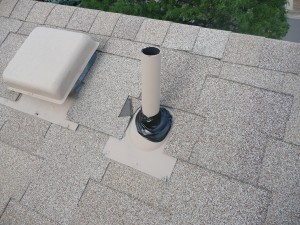What is Roof Flashing?
If your roof has been inspected or replaced, you may have heard the word flashing used to describe certain parts of your roof. Maybe the flashing needs to be replaced or water is getting under the flashing and causing a roof leak. Just what is flashing and why is it important?
Roof Flashing Materials

Flashing can be made from many different materials like plastic, tin, or galvanized metal. Flashing is used as a transition from the roofing material to something that is not a roof. Flashing is installed at intersecting roofs and parapets and walls. It typically consists of angled strips of corrosion- resistant metal that overlap in such a way as to stop water from reaching your roof decking.
Where Does Flashing Go?
For example, you need flashing where a skylight, chimney, dormer, plumbing vent or air vent extends through a roof. The roofing material stops where these elements go through the roof, and something must connect them to the roof so there is no leak. That’s the job of a flashing. Flashing protects your roof in the areas where it is most vulnerable to leaks.
Shingles on a roof play a similar role as do feathers on duck. The feather pattern and layering keep the water from ever reaching the skin of a duck. The duck stays dry. Flashing keeps this “feathered” pattern in tact on your roof and keeps the rain from ever reaching the roof decking. Without proper flashing, your roof would leak where something was extending through your roof.
Flashing has been an essential piece to proper roof construction for hundreds of years. Its design hasn’t changed much in that time period either. It is very important for the flashing to be properly installed. If you think your roof flashing is old or worn, call Excel Roofing and we will perform a free inspection to your roof.





